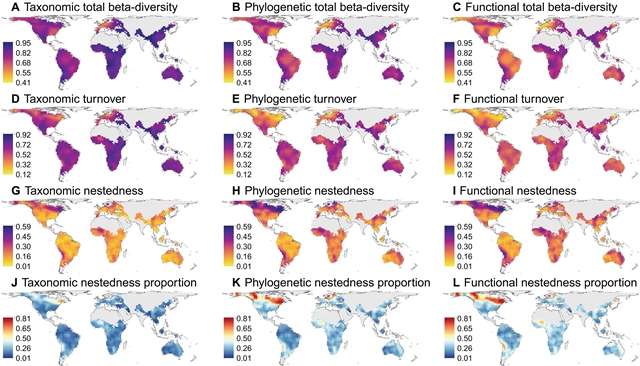
研究人员评估了第四纪气候变化对全球被子植物周边200公里细胞(β多样性)在分类学、系统发育学和功能组成上的空间差异的影响。研究发现,在所有三个生物多样性方面,更大的冰川-间冰期温度变化与β多样性的更低空间周转率(物种更替)和更高嵌套率(丰富度变化)密切相关。
此外,在经历大温度变化的地区,系统发育和功能更新比基于分类学β多样性的随机预期更低,嵌套性更强,这反映了在冰川-间冰期振荡期间物种更替、灭绝和定居系统的发育和功能选择过程。研究结果表明,未来人类驱动的气候变化可能导致全球被子植物分类、系统发育和功能多样性的局部同质化和减少。
据悉,由于地球的气候在地质时期发生了强烈的变化,通过研究过去的气候变化对生物多样性的影响有助于理解未来气候变化的风险。然而,目前尚不清楚古气候是如何塑造生物多样性的空间变化。
附:英文原文
Title: Global beta-diversity of angiosperm trees is shaped by Quaternary climate change
Author: Wu-Bing Xu, Wen-Yong Guo, Josep M. Serra-Diaz, Franziska Schrodt, Wolf L. Eiserhardt, Brian J. Enquist, Brian S. Maitner, Cory Merow, Cyrille Violle, Madhur Anand, Michal Belluau, Hans Henrik Bruun, Chaeho Byun, Jane A. Catford, Bruno E. L. Cerabolini, Eduardo Chacón-Madrigal, Daniela Ciccarelli, J. Hans C. Cornelissen, Anh Tuan Dang-Le, Angel de Frutos, Arildo S. Dias, Aelton B. Giroldo, Alvaro G. Gutiérrez, Wesley Hattingh, Tianhua He, Peter Hietz, Nate Hough-Snee, Steven Jansen, Jens Kattge, Benjamin Komac, Nathan J. B. Kraft, Koen Kramer, Sandra Lavorel, Christopher H. Lusk, Adam R. Martin, Ke-Ping Ma, Maurizio Mencuccini, Sean T. Michaletz, Vanessa Minden, Akira S. Mori, ülo Niinemets, Yusuke Onoda, Renske E. Onstein, Josep Peuelas, Valério D. Pillar, Jan Pisek, Matthew J. Pound, Bjorn J. M. Robroek, Brandon Schamp, Martijn Slot, Miao Sun, ênio E. SosinskiJr., Nadejda A. Soudzilovskaia, Nelson Thiffault, Peter M. van Bodegom, Fons van der Plas, Jingming Zheng, Jens-Christian Svenning, Alejandro Ordonez
Issue&Volume: 2023-04-05
Abstract: As Earth’s climate has varied strongly through geological time, studying the impacts of past climate change on biodiversity helps to understand the risks from future climate change. However, it remains unclear how paleoclimate shapes spatial variation in biodiversity. Here, we assessed the influence of Quaternary climate change on spatial dissimilarity in taxonomic, phylogenetic, and functional composition among neighboring 200-kilometer cells (beta-diversity) for angiosperm trees worldwide. We found that larger glacial-interglacial temperature change was strongly associated with lower spatial turnover (species replacements) and higher nestedness (richness changes) components of beta-diversity across all three biodiversity facets. Moreover, phylogenetic and functional turnover was lower and nestedness higher than random expectations based on taxonomic beta-diversity in regions that experienced large temperature change, reflecting phylogenetically and functionally selective processes in species replacement, extinction, and colonization during glacial-interglacial oscillations. Our results suggest that future human-driven climate change could cause local homogenization and reduction in taxonomic, phylogenetic, and functional diversity of angiosperm trees worldwide.
DOI: add8553
Source: https://www.science.org/doi/10.1126/sciadv.add8553
